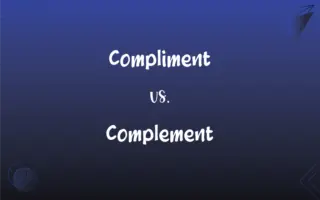Body Language vs. Paralanguage: What's the Difference?
Edited by Aimie Carlson || By Harlon Moss || Updated on October 11, 2023
Body language involves physical gestures, expressions, and postures, while paralanguage refers to vocal communication that's not spoken words, such as tone, pitch, and speed.

Key Differences
Body language, an essential component of communication, entails the use of physical actions and gestures to convey meaning and emotions. Paralanguage, on the other hand, directs focus on the non-verbal elements that accompany verbal communication, emphasizing how something is said rather than what is said.
The silent messages sent via body language, from facial expressions to postures, often convey emotional states, attitudes, and relational stances. Paralanguage, involving variations in speech like intonation, pitch, and volume, too conveys emotions, but it is also pivotal in modifying meaning and regulating conversational flow.
Body language operates on a largely visual level, providing cues that are seen and interpreted. In contrast, paralanguage plays its role audibly, utilizing sound and voice modulation to create a context or underlay emotion within verbal exchanges, impacting the listener’s interpretation.
While body language acts as a visible form of non-verbal communication, like a shrug signaling indifference or crossed arms indicating defense, paralanguage shares its messages through the audible channel, with a sigh denoting frustration or a high-pitched tone often indicating excitement or anxiety.
Comparison Chart
Medium
Visual
Audible
ADVERTISEMENT
Elements
Gestures, postures, facial expressions
Pitch, tone, speed of speech
Communication Type
Non-verbal
Vocal but non-verbal
Function
Conveys emotions, attitudes, and intentions through visible cues
Modifies and adds emotional context to verbal communication through sound
Example
Folding arms
Sighing, varying pitch
Body Language and Paralanguage Definitions
Body Language
Body language implies employing movements, such as gestures, to emphasize or accentuate verbal communication.
She used hand gestures effectively during her speech to emphasize key points.
ADVERTISEMENT
Paralanguage
Paralanguage involves the use of vocal elements, aside from words, to convey emotion and modify meaning.
Her paralanguage was evident in the sigh that accompanied her words.
Body Language
Body language encompasses using facial expressions to non-verbally communicate emotional states.
Her wide smile showed genuine happiness and approval.
Paralanguage
Paralanguage encompasses audible non-verbal elements like humming, sighing, and vocalized pauses that add context to verbal messages.
The audible eye-roll in her paralanguage was impossible to ignore.
Body Language
Body language involves using eye contact and gaze to express attentiveness, emotions, and social dynamics.
His constant eye contact demonstrated confidence and attentiveness during the interview.
Paralanguage
Paralanguage refers to variations in pitch, tone, and speed while speaking to communicate nuances and emotions.
The hurried pace of his paralanguage revealed his anxiety.
Body Language
Body language is the conveyance of feelings and intentions through physical expressions and postures.
His slouched posture indicated a lack of interest in the discussion.
Paralanguage
Paralanguage is the intentional or unintentional modulation of the voice, altering the perception of verbal communication.
His soft and slow paralanguage made his story even more touching.
Body Language
Body language refers to utilizing physical distance and positioning (proxemics) to communicate relational and emotional dynamics.
Standing closely while conversing might imply intimacy or assertiveness in body language.
Paralanguage
Paralanguage acts as an undercurrent, modifying spoken words with subtle, non-verbal auditory signals, such as pitch and rhythm variations.
The warmth in his paralanguage made the compliment feel sincere.
Paralanguage
The set of nonphonemic properties of speech, such as speaking tempo, vocal pitch, and intonational contours, that can be used to communicate attitudes or other shades of meaning.
Paralanguage
(linguistics) The non-verbal elements of speech, and to a limited extent of writing, used to modify meaning and convey emotion, such as pitch, volume, and intonation
Paralanguage
The use of manner of speaking to communicate particular meanings
FAQs
Can body language be misinterpreted?
Yes, cultural and personal differences often lead to misinterpretations of body language.
What is body language?
Body language involves communicating through physical behaviors, such as gestures, facial expressions, and posture.
Can body language be controlled?
Yes, but while some aspects can be controlled, others, like micro-expressions, often occur subconsciously.
How is body language utilized in communication?
It's used to convey emotion, emphasize verbal messages, and signal interpersonal attitudes.
Can paralanguage be controlled?
To some extent, but aspects of paralanguage, like vocal stress responses, can be involuntary.
Are body language and paralanguage learned or innate?
Both; while certain aspects are instinctive, social and cultural learning also significantly influence them.
How reliable is body language as a communication tool?
While insightful, it's not infallible due to potential misinterpretations and cultural variances.
Is body language universal?
Some aspects, like basic facial expressions, are universal, while others can vary widely between cultures.
What is paralanguage?
Paralanguage refers to vocal, non-verbal cues like pitch, tone, and speed that modify or accompany speech.
Is paralanguage important in communication?
Yes, it provides additional context, emotional tone, and subtext to verbal communication.
How does paralanguage influence verbal messages?
It adds emotional nuance, alters emphasis, and can subtly change message interpretation.
How does paralanguage differ in various cultures?
Cultural variations can influence acceptable volume, pitch, and intonation, altering paralanguage perception.
Does body language impact first impressions?
Absolutely, body language can significantly shape first impressions by communicating confidence, openness, or nervousness.
What role does paralanguage play in non-verbal communication?
Paralanguage provides a vocal, yet wordless, channel that enriches and modifies verbal communication.
Can paralanguage be used strategically in communication?
Yes, employing specific vocal cues can strategically influence how a verbal message is received and interpreted.
Can paralanguage convey information without words?
Yes, sounds like sighs, laughs, and vocal hesitations can convey meaning without words.
Can body language and paralanguage contradict verbal messages?
Yes, and such contradictions often signal deceit, confusion, or internal conflict to the observer.
Can one improve their body language reading skills?
Yes, through focused observation, knowledge acquisition, and practical application, one can improve these skills.
Why might someone intentionally modify their paralanguage?
To manage impressions, alter message delivery, or adhere to cultural and social norms in communication.
Why is understanding body language vital in communication?
It enhances interpersonal understanding by providing additional non-verbal information about emotional and mental states.
About Author
Written by
Harlon MossHarlon is a seasoned quality moderator and accomplished content writer for Difference Wiki. An alumnus of the prestigious University of California, he earned his degree in Computer Science. Leveraging his academic background, Harlon brings a meticulous and informed perspective to his work, ensuring content accuracy and excellence.
Edited by
Aimie CarlsonAimie Carlson, holding a master's degree in English literature, is a fervent English language enthusiast. She lends her writing talents to Difference Wiki, a prominent website that specializes in comparisons, offering readers insightful analyses that both captivate and inform.
































































